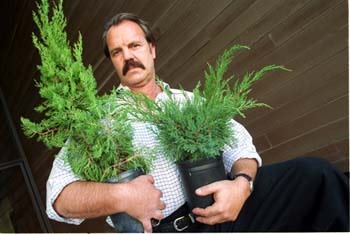Sneeze Trees

People who suffer badly from allergies dread the return of spring each year. For them, this season means sneezing, watering eyes, endless rounds of sleep-inducing allergy pills or even the ritual donning of white safety masks over noses and mouths when venturing outside. Our fertile valley is a swirling morass of ambient pollen grains at this time of year and for many people, this makes spring miserable, not happy.
Basically, pollen is the mechanism by which male flowers fertilize female flowers. Female flowers don’t produce pollen; but without it, they couldn’t produce fruit, seeds or nuts. (There are plenty of "self-pollinating" plants, with male and female flowers on one plant, or male and female parts within a single flower, on a single plant. But that’s whole nother subject.)

Norway maple (Acer platanoides) flowers – apparently highly allergenic!
So pollen is produced by male flowers. And many of the trees planted in our city streets and parks are male. Why? Because they are tidier than female trees, which – when pollinated – produce fruit or seed pods that drop on the ground and make a mess in our civic spaces. Take the ginkgo tree: most public street and park plantings consist exclusively of male selections. In fall, the female tree drops loads of squishy orange fruit that smell distinctly like dog poo so it’s quite understandable.
And most of these trees were planted before people were aware of the allergy problems associated with male plants.

Author Tom Ogren – Photo Credit: George Sakkestad
Tuesday’s New York Times printed an op-ed piece by garden writer Tom Ogren. In his piece, he explains why there are more allergen-producing plants in our cities and towns today than there were 50 years ago and suggests ways that cities can be more responsible about planting less allergenic trees. He advises against new plantings of London plane tree, box elder, and Norway maple, for instance, and suggests a number of other species that don’t produce pollen. Note: the list is limited to trees that are cold-hardy enough for New York City – thankfully, we have many more options here in Western Oregon.

If you suffer from allergies – or if you live in an urban environment close to others who might – take a peek at Ogren’s book. It could help you understand the source of your own allergies if you have them – or simply guide you to make a responsible decision about what you plant in your own garden.
